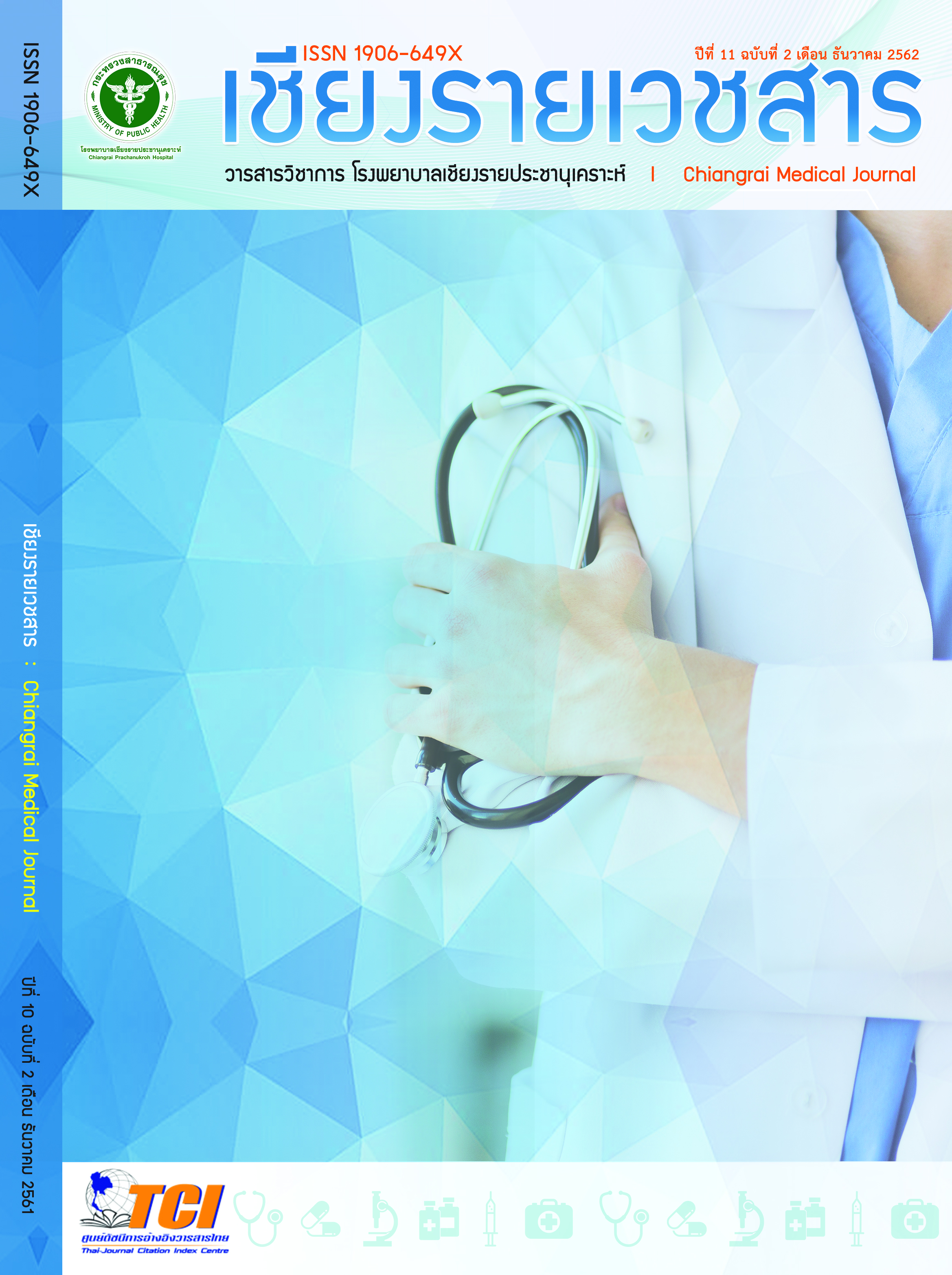ภาวะพร่องไทรอยด์ฮอร์โมนจากยารักษาวัณโรคดื้อยาหลายขนานในโรงพยาบาลสระบุรี
Main Article Content
บทคัดย่อ
ความเป็นมา ภาวะพร่องไทรอยด์ฮอร์โมนเป็นอาการข้างเคียงสำคัญที่พบได้จากการรับประทานยารักษาวัณโรคดื้อยาหลายขนาน ยาที่เป็นสาเหตุได้แก่ Ethionamide( Eto)และ Para-aminosalicylic acid(PAS) ปัจจุบันยังไม่พบข้อมูลความชุกของภาวะพร่องไทรอยด์ฮอร์โมนนี้ในประเทศไทย
วัตถุประสงค์ เพื่อหาความชุก และ หาค่ากลางระยะเวลาการเกิดภาวะพร่องไทรอยด์ฮอร์โมน ในผู้ป่วยวัณโรคดื้อยาหลายขนาน(MDR-TB)ของโรงพยาบาลสระบุรีที่ได้รับสูตรยาที่มี Eto และ/หรือ PAS เป็นองค์ประกอบ
วิธีการศึกษา เป็นการศึกษาแบบ Retrospective studyโดยการทบทวนเวชระเบียนของผู้ป่วย กลุ่มตัวอย่างเป็นผู้ป่วย MDR-TB ซึ่งถูกขึ้นทะเบียนจากคลินิกวัณโรค โรงพยาบาลสระบุรี ระหว่างวันที่ 20 ม.ค. 2552 ถึง 15 ต.ค.2561โดยผู้ป่วยได้รับสูตรยาที่มี Etoและ/หรือ PAS เป็นองค์ประกอบ และได้รับการตรวจระดับ TSHในระหว่างการรักษา การเกิดภาวะพร่องไทรอยด์ฮอร์โมนจะถูกบันทึกเมื่อระดับ TSH > 10 mIU/mlหรือแพทย์ผู้รักษาวินิจฉัยว่าเกิดภาวะพร่องไทรอยด์ฮอร์โมน
ผลการศึกษา กลุ่มตัวอย่าง 59 คน เกิดภาวะพร่องไทรอยด์ฮอร์โมนระหว่างการรักษา 37 คน (ร้อยละ62.7(95% CI, 49.1-74.9)) ค่ากลางระยะเวลาการเกิดภาวะพร่องไทรอยด์ฮอร์โมน หลังจากเริ่มยารักษาMDR-TB เท่ากับ126 วัน (IQR 81-179) ผลการวิเคราะห์ด้วย Kaplan-Meier survival analysis พบว่า ผู้ป่วยมีโอกาสเกิดภาวะพร่องไทรอยด์ฮอร์โมน ร้อยละ 50 หลังเริ่มยารักษาวัณโรคดื้อยาหลายขนานประมาณ 176วัน
สรุปและข้อเสนอแนะ ผู้ป่วยMDR-TB ทุกคนควรได้รับการตรวจTSH เพื่อค้นหาภาวะพร่องไทรอยด์ฮอร์โมนซึ่งเป็นอาการข้างเคียงที่สำคัญซึ่งการศึกษานี้พบมากถึงร้อยละ 62.7และควรตรวจอย่างต่อเนื่องตลอดระยะเวลาที่ยังรักษาด้วยสูตรยาที่มีEtoและ/หรือ PAS เป็นองค์ประกอบ
คำสำคัญ วัณโรคดื้อยาหลายขนาน ภาวะพร่องไทรอยด์ฮอร์โมน
Article Details
เอกสารอ้างอิง
Tuberculosis Control Programme Guidelines, Thailand,2013. Bangkok: The agricultural Co-operative
federation of Thailand; 2013
2. Ministry of Public Health. Department of Disease Control. Bureau of Tuberculosis. Guideline for
Programmatic Management of Drug-Resistant Tuberculosis. Bangkok: The agricultural Co-operative
federation of Thailand; 2015
3. Ministry of Public Health. Department of Disease Control. Bureau of Tuberculosis. National
Tuberculosis Control Programme Guidelines, Thailand, 2018. Bangkok: Aksorn-Graphic-and-
design;2018
4. World Health Organization. Guidelines for the programmatic management of drug-resistant
tuberculosis. Geneva, Switzerland: WHO; 2008
5. World Health Organization. Companion handbook to WHO guidelines programmatic
management of drug-resistant tuberculosis. Geneva, Switzerland: WHO; 2014
6. Drucker D, Eggo MC, Salit IE, Burrow GN. Ethionamide-induced goitroushypothyroidism. Ann
Intern Med. 1984; 100:837-9.
7. McDonnell ME, Braverman LE, Bernardo J. Hypothyroidism due to ethionamide. N Engl J
Med. 2005; 352:2757-9.
8. Davie HT, Galbraith HJ. Goitre and hypothyroidism developing during treatment with P.A.S.
BrMed J. 1953; 1:1261.
9. Hamilton RR. Effect of P.A.S. on the thyroid gland. Br Med J. 1953:1(4800):29-30. PubMed
PMID:12997825
10.Furin JJ, mitnick CD, Shin SS, Bayona J, Becerra MC, Singler JM, et al. Occurrence of
serious adverse in patients receiving community-based therapy for multidrug-resistant
tuberculosis. Int J Tuberc Lung Dis. 2001;5:648-55. PubMed PMID:11467371
11.Andries A, Isaakidis P, Das M, Khan S, Paryani R, Desai C, et al. High Rate of
Hypothyroidism in Multidrug-Resistant Tuberculosis Patients Co-Infected with HIV in Mumbai,
India. PloSOne(internet). 2013 (cited 2018 Nov 4);8(10):e78313. Available from:
https://journals.plos.org/plosone/article?id=10.1371/journal.pone.0078313
12.Dutta BS, Hassa G, Waseem Q, Saheer S, Singh A, Ethionamide-induced hypothyroidism.
Int J Tuberc Lung Dis off J Int Union Against Tuberc Lung Dis. 2012;1G(1):141. http://dx.doi.
Org/10.5588/ijtld.11.0388.
13.Srivanichakorn W. Treatment for thyroid hormone deficiency. In: Phisalprapa P, Siwamogsatham S,
Sura T, editors. Ambulatory medicine The Survivors. Bangkok: Thepphenvanish; 2016.p.149-65
14.Satti H, Mafukidze A, Jooste PL, McLaughlin MM, Farmer PE, Seung KJ. High Rate of
Hypothyroidism among Patients Treated for MDR-TB in Lesotho. Int J Tuberc Lung Dis
(internet). 2012 (cited 2018 Nov 4);16(4), 468-72. Available from:
http://dx.doi.org/10.5588/ijtld.11.0615
15.Modongo C, Zetola NM. (2012) Prevalence of Hypothyroidism among MDR-TB Patients
in Botswana. Int J Tuberc Lung Dis. 2012;16(11):1561-2. doi: 10.5588/ijtld.12.0403. PubMed
PMID:23044454
16.Munivenkatappa S, Anil S, Naik B, Volkmann T, Sagili KD, Akshatha JS, et all. Drug-induced
Hypothyroidism during Anti-Tuberculosis Treatment of Multidrug-Resistant


